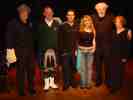|
Telford Bicentennial Sees
Pulteneytown Heritage Funds Announcement
Some History Pulteneytown was the wild west of its day with the population rising cconstantly8 and workers and fishermen coming in from many countries. Over 40 pubs in served over 800 gallons of whisky each week and fights and brawls were common. In 1848 a huge storm swamped the fleet of fishing boats out in Wick Bay. 37 men were drowned. 1860 saw the introduction of cotton nets instead of the former hemp ones. This trebled the catching power of the fishing boats and the towns fortunes soared. Over 50,000 crans were caught in one two day period and Wick is now exporting over one third of the total Scottish catch - nearly 130,000 barrels a year. In 1861 there were 94 fish curing firms, 5000 fishermen, 3000 gutters, 14 blacksmiths, 75 shoemakers and a whole host of other trades hard at work in the area. The telegraph arrived at wick in 1869 followed in 1874 by the railway. By 1875 the boats are much larger with full decking and higher catching power. The numbers are back down to about 400. In 1899 the first steam drifter arrived in Wick. By 1908 the numbers of steam drifters reaches 25 and sailing vessels is at 288 The population has been in long slow decline and by 1911 there are 22 steam drifters and 169 sail fishing boats. 1914 and the outbreak of the First World War sees the end of the Herring Fishing as it had been. By 1923 there are 16 steam, 10 sail and 34 motor vessels. In the period 1928 - 1935 continual decline reduces the fleet followed by an export ban to Russia - the biggest market. This is followed by more emigration from Caithness. In 1936 there is a revival and the boats numbers stand at 13 steam and 23 motor boats. 1937 saw the first Herring Queen festival 1981 saw the last cooperage close in Wick after 500 years of the trade in the area. 2003 and the main fishing from Wick is crab and prawn fishing due to the fact that Wick is no longer a designated port under European rules. A few boats still have Wick as their home port but are mainly berthed at Scrabster where the fish is landed. Much more information and pictures on the whole period can be found at Wick Heritage Museum |


